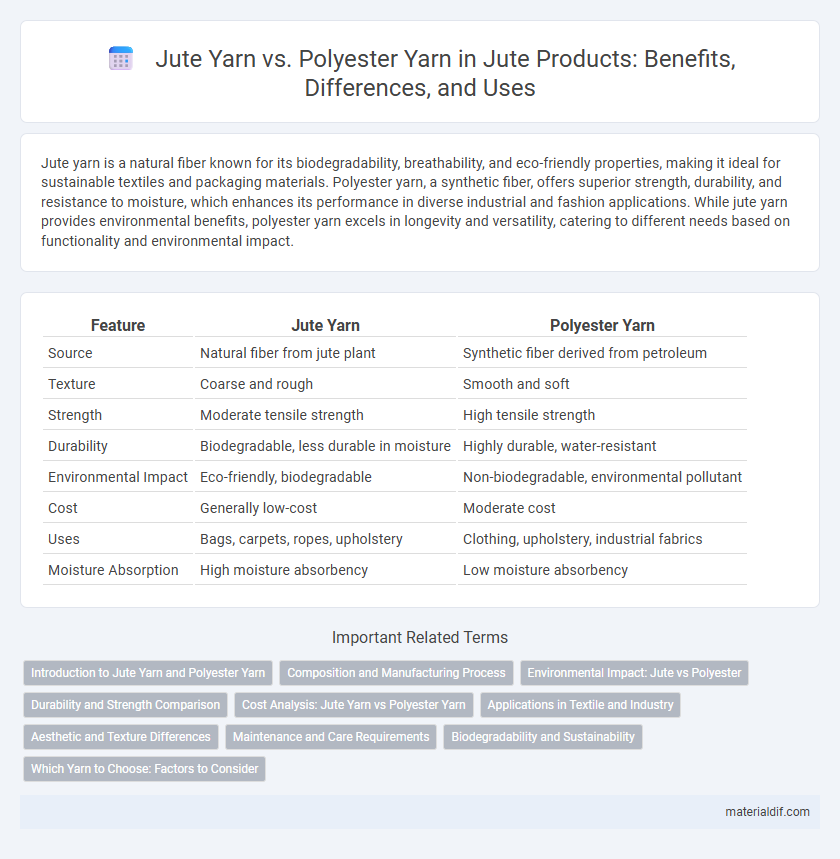Jute yarn is a natural fiber known for its biodegradability, breathability, and eco-friendly properties, making it ideal for sustainable textiles and packaging materials. Polyester yarn, a synthetic fiber, offers superior strength, durability, and resistance to moisture, which enhances its performance in diverse industrial and fashion applications. While jute yarn provides environmental benefits, polyester yarn excels in longevity and versatility, catering to different needs based on functionality and environmental impact.
Table of Comparison
| Feature | Jute Yarn | Polyester Yarn |
|---|---|---|
| Source | Natural fiber from jute plant | Synthetic fiber derived from petroleum |
| Texture | Coarse and rough | Smooth and soft |
| Strength | Moderate tensile strength | High tensile strength |
| Durability | Biodegradable, less durable in moisture | Highly durable, water-resistant |
| Environmental Impact | Eco-friendly, biodegradable | Non-biodegradable, environmental pollutant |
| Cost | Generally low-cost | Moderate cost |
| Uses | Bags, carpets, ropes, upholstery | Clothing, upholstery, industrial fabrics |
| Moisture Absorption | High moisture absorbency | Low moisture absorbency |
Introduction to Jute Yarn and Polyester Yarn
Jute yarn is a natural fiber derived from the jute plant, known for its biodegradability, strength, and eco-friendly properties, making it popular in sustainable textiles and packaging. Polyester yarn, a synthetic fiber made from petroleum-based polymers, offers high durability, resistance to stretching and shrinking, and moisture-wicking capabilities, which suit it for a wide range of industrial and fashion applications. Both yarns serve distinct purposes, with jute emphasizing environmental benefits and polyester providing enhanced performance and versatility.
Composition and Manufacturing Process
Jute yarn is composed primarily of natural cellulose fibers derived from the jute plant, undergoing processes like retting, stripping, and spinning to produce coarse, eco-friendly threads. Polyester yarn consists of synthetic polymer fibers created through a chemical reaction involving purified terephthalic acid and ethylene glycol, forming long chains that are extruded and spun into fine, uniform yarns. The manufacturing of jute emphasizes biological and mechanical methods, whereas polyester production relies on petrochemical synthesis and advanced industrial extrusion techniques.
Environmental Impact: Jute vs Polyester
Jute yarn is biodegradable, renewable, and requires minimal water and pesticides during cultivation, making it highly eco-friendly compared to polyester yarn, which is derived from non-renewable petroleum and contributes to microplastic pollution. The production of polyester yarn involves significant energy consumption and releases greenhouse gases, whereas jute cultivation enhances soil fertility and absorbs carbon dioxide. Choosing jute yarn reduces environmental degradation and supports sustainable agricultural practices.
Durability and Strength Comparison
Jute yarn, derived from natural plant fibers, offers moderate strength and biodegradability but is less durable under prolonged stress and moisture exposure compared to polyester yarn. Polyester yarn, a synthetic fiber, exhibits superior tensile strength, resistance to abrasion, and longevity, making it ideal for heavy-duty applications requiring sustained durability. The strength-to-weight ratio favors polyester yarn, providing enhanced performance in industrial and textile uses where durability is critical.
Cost Analysis: Jute Yarn vs Polyester Yarn
Jute yarn is significantly more cost-effective than polyester yarn due to its natural availability and lower production expenses, making it a preferred choice for eco-friendly and budget-conscious applications. Polyester yarn involves higher manufacturing costs, including synthetic fiber production and energy consumption, which contribute to its greater market price. Despite polyester yarn's durability and versatility, the lower raw material and processing costs of jute yarn ensure more economical pricing for bulk textile and packaging uses.
Applications in Textile and Industry
Jute yarn is widely used in eco-friendly textiles, such as bags, rugs, and upholstery, due to its biodegradability and natural strength, making it ideal for sustainable fashion and home decor. Polyester yarn, known for its durability, elasticity, and resistance to moisture, dominates the production of sportswear, industrial fabrics, and upholstery where high-performance and easy maintenance are required. Industrial applications favor polyester yarn for conveyor belts, airbags, and safety gear, while jute yarn is preferred for agricultural sacks, geo-textiles, and packaging materials because of its cost-effectiveness and environmental benefits.
Aesthetic and Texture Differences
Jute yarn exhibits a coarse, natural texture with an earthy, matte finish that enhances rustic and organic aesthetics, ideal for eco-friendly textiles and decor. Polyester yarn features a smooth, consistent texture with a glossy sheen, offering vibrant color retention and a polished appearance suitable for modern and synthetic fabric applications. The tactile contrast between jute's roughness and polyester's sleekness defines their distinct uses in fashion and interior design.
Maintenance and Care Requirements
Jute yarn demands careful handling due to its natural fiber composition, requiring dry storage and protection from moisture to prevent mold and degradation, while polyester yarn is low-maintenance, resistant to wrinkles, and unaffected by water exposure. Unlike jute, polyester yarn can be machine washed and dried with minimal risk of damage or color fading. The durability of polyester yarn under varied environmental conditions makes it a preferred choice for applications requiring easy cleaning and long-term use.
Biodegradability and Sustainability
Jute yarn is highly biodegradable and compostable within months, making it a sustainable choice for eco-friendly applications, whereas polyester yarn, derived from petroleum-based polymers, resists natural decomposition and contributes to long-term environmental pollution. The renewable nature of jute crops, which require minimal pesticides and water, enhances the sustainability profile of jute yarn compared to the energy-intensive production and non-biodegradability of polyester yarn. Opting for jute yarn supports reduced carbon footprint and less plastic waste accumulation, crucial for sustainable textile industries.
Which Yarn to Choose: Factors to Consider
When choosing between jute yarn and polyester yarn, consider factors such as environmental impact, durability, and application requirements. Jute yarn is biodegradable, eco-friendly, and ideal for sustainable products, while polyester yarn offers superior strength, elasticity, and resistance to moisture and chemicals. The decision depends on whether priority is given to natural fiber benefits or enhanced performance characteristics for specific industrial or textile uses.
Jute Yarn vs Polyester Yarn Infographic

 materialdif.com
materialdif.com